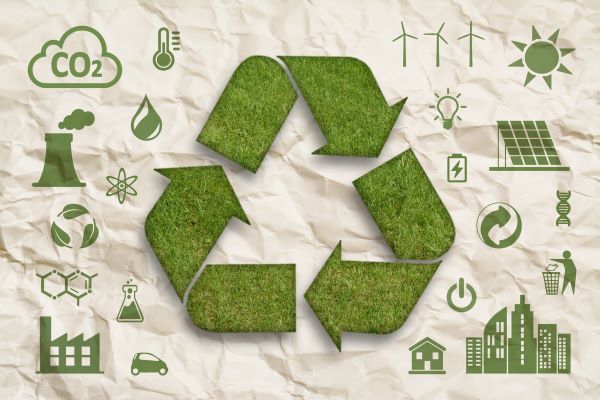From the waste room to the boardroom, we must think about more than just recycling - and it starts with dumping the end-of-life concept, says Stantec’s Dave Garner.
Consumption and resource management was omitted from the COP26 talks. This was concerning as consumption is a cornerstone of climate change. We’re in a privileged period of human history, wealthier than previous generations, with access to lifestyles our ancestors didn’t dream about.
However, will we maintain this if we continue with consumption levels and the linear economy model that our success is built on? I imagine not. The linear economy has reached its limits.
We need to evolve to a circular economy - one that is restorative or regenerative by intention and design. This replaces the ‘end-of-life’ concept with restoration, shifts towards the use of renewable energy and eliminates the use of toxic chemicals, which impair reuse.
The ten Rs for material management
At the start of my career, there were three Rs: Reduce, Reuse, and Recycle. In a circular economy there are ten Rs, with focus shifted to the very top of the waste hierarchy—prevention and minimisation. The circular economy shifts the view of product and service impacts from the bottom to the top of the decision process. From the most preferred option to the least, the ten Rs descend in order as follows.
- Refuse: Refuse a product.
- Rethink: Make products more intensive (e.g., sharing, multifunctional products) or offer the same function with a radically different product.
- Reduce: Increase efficiency of manufacture.
- Reuse: By another consumer.
- Repair: Repair and maintenance.
- Refurbish: Restore an old product and bring it up to date.
- Remanufacture: Use parts of a discarded product in a new product with the same function.
- Repurpose: Use parts of a discarded product in a new product with different function.
- Recycle: Process materials to obtain same (high grade) or lower (low grade) quality.
- Recover: Incineration with energy recovery.
Common sense and business sense
The circular economy makes excellent business sense - you get the most from the resources you have and minimising resources you buy. A circular strategy enables organisations and economies to benefit from substantial net material savings, mitigation of volatility and supply risks. It drives innovation and jobs, improves land productivity, soil health and long-term economic resilience.
In the UK, England’s Resource and Waste Strategy, the new Environment Act, and UK Circular Economy Package all identify actions to facilitate change. The Greater London Authority now requires a circular economy statement from major developments, a move likely to be replicated.

Help, not a hindrance
This should be an opportunity, not a barrier. Decisions on materials need to be shifted from the end of a project to the beginning, to be reviewed at key milestones, and to have buy-in from the top down. Changing to a circular model is a challenge, taking time, expertise, and conviction, but with significant benefits for all.
In the US, a barrier in all recycling avenues is that lack of policy or regulatory oversight of product quality and standards. This affects value, and when value is diminished, markets either disappear or never emerge. Without regulatory oversight, it’s hard to promote a viable supply chain to stabilise markets. Without viable markets, the incentives to reclaim or reuse fall away.
The UK and EU have more consistent regulatory frameworks for respective supply chains, and now the regions can close the loops in a more coordinated manner.
Shifting to a circular model will enable economic growth while restoring and regenerating all available types of capital (financial, human, social, and natural). Success will create organisations and an economy to support a better world than we have today, a legacy to be truly proud of!
Leading by example
On a personal note, ten years ago my wife and I started our mobile device buyback, repair, and reuse business. We provided a simple and easy method to manage old devices in a data secure, legally compliant and best environmental outcome way. Assets were tested and graded, whereby clients could donate the value to charity or retain the value. Devices were cleaned or repaired or refurbished and sold for reuse, obsolete or unrepairable devices were recycled. We led with financial, data security, social, and environmental benefits, in this order. For clients to successfully embrace circularity, we should support and encourage a similar order.
The UK government is increasingly committed to driving economic growth in a much more efficient manner that relies less on imported and virgin material. Moving toward a more circular economy can contribute to this and is essential for future growth, increased resilience, and environmental and human health.
Choosing to complete the circle
The choices we make are essential to our future. Whether it’s diverting biodegradable waste from the landfill, extracting phosphorus - a fundamental ingredient in every living cell - from wastewater to recover it for agricultural fertiliser, or turning an obsolete medical campus into housing, the circular economy is our future. It’s critical that we look at every project as an opportunity to restore and think about the circular economy.
We must prolong the lives of the materials and goods that we use, moving society away from the current inefficient linear economic model. Wherever we can, we should focus on circular, recovering and regenerating products and materials, giving them a continuous lease of life.
Dave Garner is an associate sustainability consultant at Stantec.

